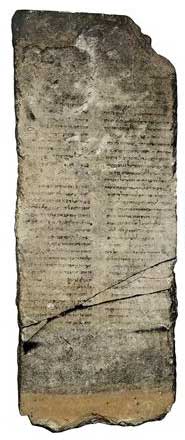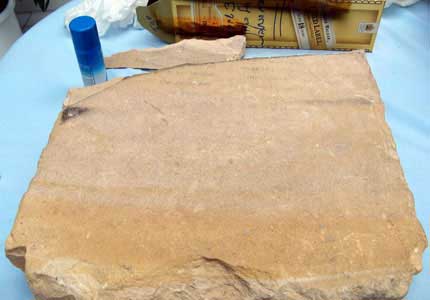 I just came home from the lake and noticed that many news sources are carrying a story about a paper that Professor Israel Knohl presented at an Israel Museum conference on his interpretation of the so-called “Gabriel’s Revelation” tablet. Knohl argues that the best reading of line 80 of the text is “In three days you shall live, I Gabriel, command you”, and that this text is a pre-Christian reference to the death and resurrection of a Jewish leader.
I just came home from the lake and noticed that many news sources are carrying a story about a paper that Professor Israel Knohl presented at an Israel Museum conference on his interpretation of the so-called “Gabriel’s Revelation” tablet. Knohl argues that the best reading of line 80 of the text is “In three days you shall live, I Gabriel, command you”, and that this text is a pre-Christian reference to the death and resurrection of a Jewish leader.
The tablet was actually discovered a decade ago and has been dated by paleography to the end of the first century B.C.E. The provenance of the tablet is unfortunately unknown since it was purchased from an antiquities dealer. It is claimed it was found near the Dead Sea.
Here is an excerpt from the news story from The Independent:
Using other lines in the text that refer to blood and slaughter as routes to righteousness, along with the overall context of the Jewish revolt against the Romans at the time, Professor Knohl suggests that it refers to the death and resurrection of a Jewish leader.
The tablet, known as Gabriel’s Vision of Revelations because it contains an apocalyptic text ascribed to the angel, has attracted the intense interest of scholars. It came to light after it was bought from a Jordanian antiquities dealer by an Israeli-Swiss collector, David Jeselsohn, who kept it in his Zurich home. The location of the original discovery is not clear, though it may have been in Jordan on the eastern shore of the Dead Sea.
Two Israeli scholars, Ada Yardeni and Binyamin Elitzur, published a detailed analysis of the Hebrew script, which is written rather than engraved in the stone, last year, dating it towards the end of the first century BC. But when it came to the crucial line 80 in the script, which clearly begins “in three days”, the scholars concluded that the next word was illegible.
Professor Knohl argues that the word is “Hayeh” or “live” in the imperative. He goes on to outline his conjecture that the messianic figure could be a rebel leader against the Roman-backed monarchy of Herod named Shimon, who the historian Josephus says was killed by one of Herod’s military commanders.
He will claim today that the interpretation vindicates a theory which he had already expounded in a book in 2000, namely that the idea of a suffering messiah existed before Jesus.
Claiming that the idea that Jesus died to redeem the sins of all mankind was in large part generated by St Paul, who wanted Jesus to be a messiah “of the gentiles”, he said yesterday that the earlier Jewish tradition would have seen his death as necessary “to cause God to defeat the enemy, to liberate Jerusalem from the Roman occupation”. He added: “He was fighting for the liberty of the Jewish people. That is how I see it.”
Not all scholars at today’s conference are likely to be convinced, however. Professor Lawrence Schiffman, Professor of Hebrew and Judaic Studies at New York University, said that a single detail of a “phenomenal” text was being used to create a “media experience”.

I have not read the article by Yardeni and Elitzur, nor have I seen the tablet (or a picture or transcription of it), so I can’t really comment on whether Knohl’s reading is plausible. What I can say is that this reading, if correct, does nothing to diminish the Christian belief in the resurrection of Jesus. If anything, this reading only shows once again that the early church is clearly rooted in the first century Jewish community.
UPDATE: BAR has a special news report that includes the article Yardeni published in the January/February 2008 issue of BAR (“A New Dead Sea Scroll in Stone?”) as well as her transcription of the Hebrew text and English translation.

Pingback: More on the “Gabriel Inscription” with some pictures | PaleoBabble
Pingback: Bookmarks about Script